The Wooden Cutlery Market is estimated to be valued at USD 212.2 billion in 2025 and is projected to reach USD 339.1 billion by 2035, registering a compound annual growth rate (CAGR) of 4.8% over the forecast period.
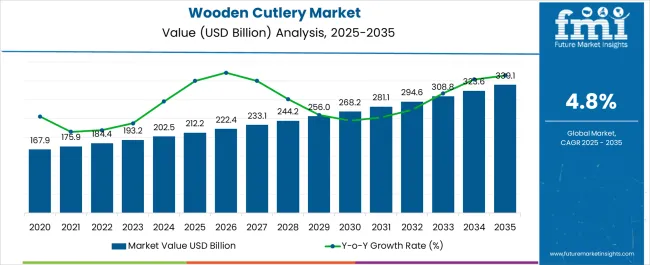
| Metric | Value |
|---|---|
| Wooden Cutlery Market Estimated Value in (2025 E) | USD 212.2 billion |
| Wooden Cutlery Market Forecast Value in (2035 F) | USD 339.1 billion |
| Forecast CAGR (2025 to 2035) | 4.8% |
The wooden cutlery market is experiencing robust expansion driven by increasing restrictions on single use plastics and heightened consumer preference for sustainable alternatives. The food service industry has emerged as a major adopter of wooden cutlery due to growing demand for eco friendly tableware in quick service restaurants, cafes, and catering services.
Advances in manufacturing processes have improved durability, finish quality, and cost efficiency, making wooden cutlery a viable alternative to plastic. In addition, rising consumer awareness about environmental impact and waste reduction has influenced purchasing decisions in favor of biodegradable and compostable options.
Supportive policies in regions such as Europe and North America are accelerating the transition to wooden products, while emerging economies are witnessing a surge in adoption led by urbanization and rising disposable incomes. The outlook for the market remains positive as industries and consumers increasingly align with sustainability goals and circular economy principles.
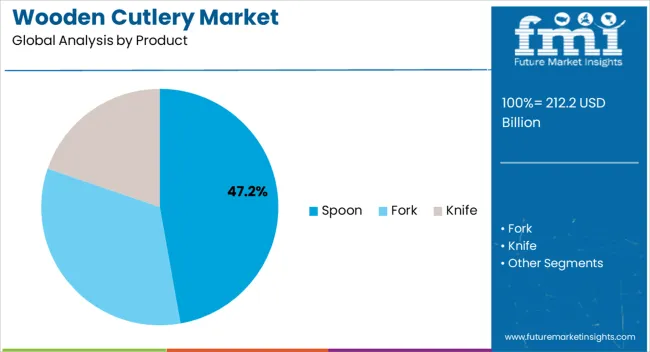
The spoon segment is projected to account for 47.20% of total market revenue by 2025 within the product category, making it the largest product type. The growth of this segment is supported by its widespread usage in food service, takeaway, and packaged meal applications.
Wooden spoons are favored due to their versatility, durability, and compatibility with a wide variety of cuisines. Increased adoption in both casual dining and quick service outlets has reinforced demand.
Furthermore, rising environmental awareness has shifted preference toward wooden spoons as consumers seek alternatives that are both functional and eco friendly. This combination of high usability and sustainability credentials has positioned the spoon segment at the forefront of product growth.
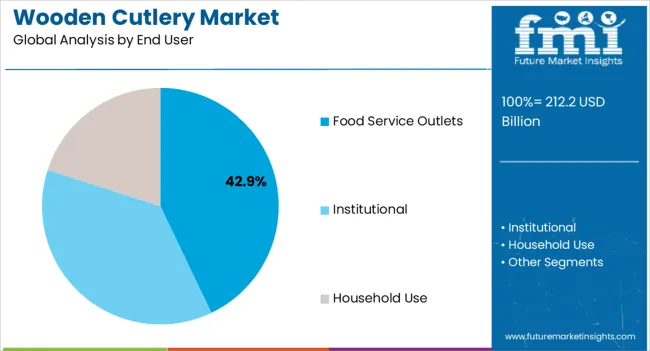
The food service outlets segment is expected to contribute 42.90% of overall market revenue by 2025 under the end user category, making it the leading segment. The expansion of quick service restaurants, cafes, and catering services has created substantial demand for disposable but sustainable cutlery options.
Wooden cutlery has become a preferred solution due to regulatory restrictions on plastic and increasing focus on green dining experiences. Food service operators have adopted wooden cutlery to strengthen their environmental branding and respond to consumer expectations of eco conscious dining.
This alignment with both regulatory frameworks and customer values has cemented the dominance of food service outlets in this market.
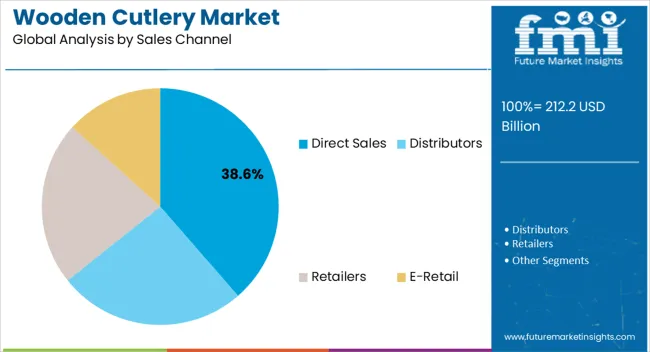
The direct sales segment is anticipated to represent 38.60% of total market revenue by 2025 within the sales channel category, positioning it as the largest distribution channel. This dominance is attributed to the ability of manufacturers and distributors to build direct relationships with large scale buyers such as food service chains, catering companies, and institutional clients.
Direct sales enable better pricing strategies, customized solutions, and streamlined supply chains that reduce overhead costs. The growing trend of businesses seeking long term sustainable supply partnerships has further accelerated the adoption of direct sales channels.
This model ensures consistent demand fulfillment while offering clients greater flexibility and responsiveness, establishing it as the leading sales channel in the wooden cutlery market.
The global demand for wooden cutlery is projected to increase at a CAGR of 2.2% during the forecast period between 2020 and 2025, reaching a total of USD 339.1 million in 2035. According to Future Market Insights, a market research and competitive intelligence provider, the wooden cutlery market was valued at USD 212.2 million in 2025.
From 2020 to 2025, the global market witnessed steady growth, owing to the growing awareness of health and safety. People are actively seeking out safer alternatives for their everyday use, including cutlery, as they become more conscious of the potential health risks associated with certain materials.
Wooden cutlery is generally considered safe and hygienic for use in the food industry. Wooden cutlery is free from such chemical additives, unlike plastic utensils, which can leach harmful chemicals such as BPA (bisphenol A) into food. BPA is a synthetic compound commonly found in plastics and has been linked to various health concerns, including hormonal disruptions and potential risks to human health. Individuals can minimize their exposure to these potentially harmful chemicals, by choosing wooden cutlery.
Wooden cutlery is typically sourced from natural materials such as bamboo or birchwood, which do not contain any toxic substances. The materials are known for their low allergenic potential, making wooden cutlery a suitable option for individuals with sensitivities or allergies to certain materials, such as plastics or metals.
Wooden cutlery also offers inherent antimicrobial properties. Wood has natural antimicrobial qualities that can inhibit the growth of bacteria, making it a hygienic choice for food contact surfaces. The porous nature of wood allows it to absorb moisture, which helps to prevent the proliferation of bacteria. It is important to note that proper cleaning and maintenance practices are still essential to ensure the hygiene of wooden cutlery.
The awareness of health and safety extends beyond the individual consumer to the foodservice industry as well. Restaurants, cafes, and other food establishments are recognizing the importance of providing safe and healthy dining experiences to their customers. Using wooden cutlery not only meets their customers' expectations for safe utensils but also aligns with their commitment to food safety and hygiene standards.
Growing Preference for Sustainable & Eco-Friendly Products are Likely to be Beneficial for Market Growth
The growing preference for sustainable and eco-friendly products is a major factor driving the growth of the wooden cutlery market. Consumers are actively seeking alternatives that are more sustainable and less harmful to the planet, with increasing awareness about the negative impact of single-use plastics on the environment.
Wooden cutlery has gained significant popularity due to its eco-friendly nature. It is made from renewable resources, primarily sourced from fast-growing trees such as birch, bamboo, or other sustainable wood varieties. The trees can be harvested and replenished relatively quickly, making wooden cutlery a more sustainable option compared to plastic cutlery, which is derived from non-renewable fossil fuels.
One of the key advantages of wooden cutlery is its biodegradability. When disposed of, wooden cutlery breaks down naturally over time, returning to the earth without leaving behind harmful microplastics or polluting the environment, which aligns with the principles of the circular economy, where products are designed to have minimal impact on the environment and can be regenerated or recycled.
Increasing Adoption in the Food Service Industry to Fuel Market Growth
The increasing adoption of wooden cutlery in the food service industry is a significant trend that is boosting the growth of the wooden cutlery market. Restaurants, cafes, and catering services are recognizing the benefits of using wooden cutlery, both from a sustainability perspective and as a means to enhance the overall dining experience for their customers.
One of the key reasons for the adoption of wooden cutlery in the foodservice industry is its sustainable nature. Consumers expect food establishments to align with their values and offer eco-friendly options, as consumers become more environmentally conscious. Wooden cutlery fits well with the sustainability initiatives of foodservice establishments, as it is made from renewable resources and is biodegradable.
Wooden cutlery provides an alternative to traditional plastic cutlery, which is known for its negative environmental impact. Food service businesses, by using wooden cutlery, can significantly reduce their plastic waste and contribute to a greener and more sustainable future, which resonates with environmentally conscious customers who appreciate businesses that prioritize sustainability and take steps to minimize their ecological footprint.
Spoons to Take the Lion’s Share
Spoons are the most commonly used cutlery in kitchenware and dinnerware. The increasing demand for on-the-go food and takeaway food providers is expected to result in a positive outlook towards the global wooden cutlery market and the same segment is projected to hold the major share of the market with more than 50% in 2025. The segment is expected to hold a CAGR of 4.7% during the forecast period.
Food Service Outlets to Take the Lion’s Share
Based on end use, the food service outlets segment is estimated to remain the leading segment among the other segment and shall grow at a CAGR of 5.0% during the forecast period. Growing demand for wooden cutlery in quick-service restaurants is the major factor creating growth opportunities for the market.
E-Retail to Take the Lion’s Share
The advancement in the E-retail sector is estimated that sales of wooden cutlery will gain significant traction in the near future which is due to the developing trend for online purchases, which provides discounts, offers, and easy shipping.
It also provides a large variety of options for customers and is expected to capture nearly 43% value share in 2025 in the global market. The segment is expected to hold a CAGR of 4.5% during the forecast period.
Increase in QSRs Creating Lucrative Opportunities in the United States
The United States is anticipated to hold around 92% of total sales in North America in 2025. North America dominates the wooden cutlery market due to continuous increase in the number of QSR and fast-food service providers.
According to Biodegradable Products Institute, the shift in the circular economy in the United States by promoting the production, use, and design of fully biodegradable and compostable products will accelerate the demand for eco-friendly tableware and packaging solutions. The country is expected to hold a CAGR of 4.7% over the analysis period.
Expanding Food & Beverage Industry to Create Lucrative Opportunities in Germany
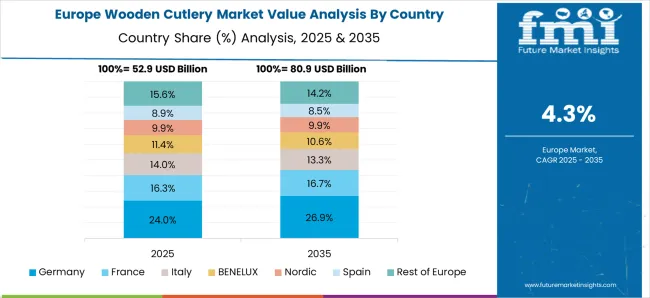
According to FMI analysis, the wooden cutlery market in Germany is expected to expand at a significantly high CAGR of 2.6% during the forecast period. Germany holds a major part of the Europe wooden cutlery market which accounts for 18% of the market share in 2025.
According to Germany Trade & Invest (GTAI), Germany is Europe's largest food producer and the food & beverage industry represents the fourth largest industry sector in Germany.
Wooden cutlery market startup players are adopting various marketing strategies such as new product launches, geographical expansion, merger and acquisitions, partnerships and collaboration to create a larger customer base. For instance,
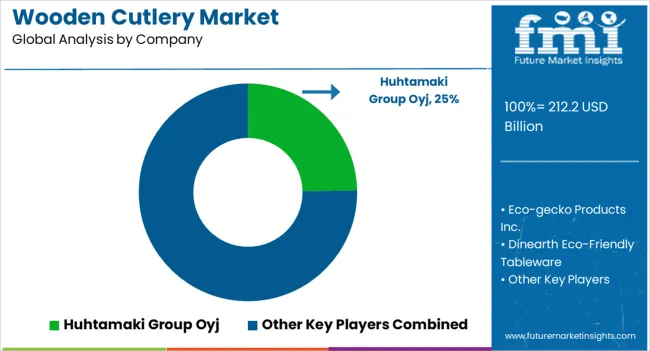
Key players in the wooden cutlery market are strongly focusing on profit generation from their existing product portfolios along while exploring potential new applications. The players are emphasizing on increasing their wooden cutlery production capacities, to cater to the demand from numerous end use industries. Prominent players are also pushing for geographical expansion to decrease the dependency on imported wooden cutlery.
Recent Developments
| Attribute | Details |
|---|---|
| Expected Market Value in 2025 | USD 193.2 million |
| Projected Market Value in 2035 | USD 308.8 million |
| Expected Growth Rate from 2025 to 2035 | CAGR of 4.8% |
| Forecast Period | 2025 to 2035 |
| Historical Data Available for | 2020 to 2025 |
| Market Analysis | USD million in value |
| Key Regions Covered | North America; Latin America; Western Europe; Eastern Europe; East Asia; South Asia & Pacific; Middle East & Africa |
| Key Countries Covered | United States, Canada, Brazil, Mexico, Germany, United Kingdom, France, Spain, Italy, Poland, Russia, Czech Republic, Romania, India, Bangladesh, Australia, New Zealand, China, Japan, South Korea, GCC Countries, South Africa, Israel |
| Key Segments Covered | Product, End Use, Sales Channel, Region |
| Key Companies Profiled | Huhtamaki Group Oyj; Eco-gecko Products Inc.; Dinearth Eco-Friendly Tableware; Greenwood (Dalian) Industrial Co., Ltd.; Bambu LLC; Eco-gecko Products Inc.; Vegware Ltd.; Biotrem; Bio Futura B.V.; Ecoware Biodegradables Inc.; Ecoriti; Vrag Fils Airlaid Pvt. Ltd.; Natural Tableware; Packnwood (First Pack); Pavrex Wooden Products; Greenwood (Dalian) Industrial Co., Ltd.:; Pappco Greenware |
| Customization & Pricing | Available upon Request |
The global wooden cutlery market is estimated to be valued at USD 212.2 billion in 2025.
The market size for the wooden cutlery market is projected to reach USD 339.1 billion by 2035.
The wooden cutlery market is expected to grow at a 4.8% CAGR between 2025 and 2035.
The key product types in wooden cutlery market are spoon, fork and knife.
In terms of end user, food service outlets segment to command 42.9% share in the wooden cutlery market in 2025.






Full Research Suite comprises of:
Market outlook & trends analysis
Interviews & case studies
Strategic recommendations
Vendor profiles & capabilities analysis
5-year forecasts
8 regions and 60+ country-level data splits
Market segment data splits
12 months of continuous data updates
DELIVERED AS:
PDF EXCEL ONLINE
Wooden & Plywood Packaging Market Size and Share Forecast Outlook 2025 to 2035
Wooden Furniture Market Size and Share Forecast Outlook 2025 to 2035
Wooden Interior Door Market Size and Share Forecast Outlook 2025 to 2035
Wooden Decking Market Size, Growth, and Forecast 2025 to 2035
Wooden Barrels Market Growth - Demand & Forecast 2025 to 2035
Market Share Insights of Wooden Crate Providers
Wooden Box Market Demand & Premium Packaging Trends 2024-2034
Wooden Crate Market by Hardwood & Softwood from 2024 to 2034
Wooden Pallets Market
Wooden Pallet Collars Market
Cutlery Market Growth – Trends & Demand Forecast 2025-2035
Plastic Cutlery Market Demand & Convenience Packaging Trends 2024-2034
Bio-based Cutlery Market Growth & Demand 2024-2034
Commercial Cutlery Market Size and Share Forecast Outlook 2025 to 2035
Disposable Cutlery Market Size, Growth, and Forecast 2025 to 2035
Competitive Breakdown of Disposable Cutlery Providers
Biodegradable Cutlery Market
Japan Disposable Cutlery Market Analysis by Product Type, Fabrication Process, Cutlery Type, Sales Channel, End Use, and Region Forecast through 2035
Bagasse Disposable Cutlery Market Size and Share Forecast Outlook 2025 to 2035
Examining Market Share Trends in Bagasse Disposable Cutlery

Thank you!
You will receive an email from our Business Development Manager. Please be sure to check your SPAM/JUNK folder too.
Chat With
MaRIA